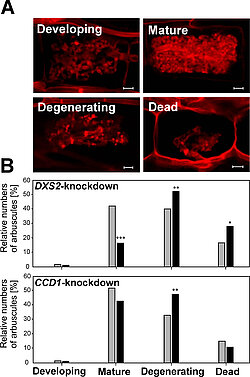Carotenoid Metabolism & Mycorrhiza
Research Mission and Profile
Molecular Signal Processing
Bioorganic Chemistry
Biochemistry of Plant Interactions
Cell and Metabolic Biology
Independent Junior Research Groups
Program Center MetaCom
Publications
Good Scientific Practice
Research Funding
Networks and Collaborative Projects
Symposia and Colloquia
Alumni Research Groups
Dynamics of arbuscule development and degeneration linked to CH/MR accumulation
Dynamics of arbuscule development and degeneration linked to CH/MR accumulation
Based on a number of experimental results, a model has been presented, which predicts a role for CH apocarotenoids in arbuscule turnover by acting as a cell-specifically produced plant allelochemical on the fungus. This may promote or accelerate the degeneration of fungal arbuscules poorly delivering mineral nutrients without harming the plant cell.
Fig. 4: (A) Four stages of arbuscule development defined from roots of Medicago truncatula. (B) Alterations in the distribution of these stages in hairy roots of M. truncatula of empty vector controls (grey bars) as compared to roots expressing knockdown RNAi constructs (black bars) for DXS2 (top) or CCD1 (bottom). Only in the case of DXS2 knockdown was there a strong reduction CH derivatives correlated with reduced numbers of mature arbuscules as corroborated by strongly decreased transcript levels of the arbuscule functional marker MtPT4 (not shown).
This page was last modified on 27 Jan 2025 27 Jan 2025 27 Jan 2025 .


